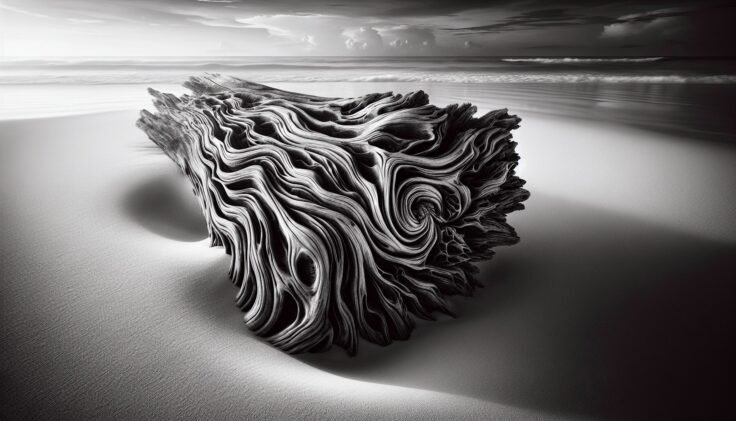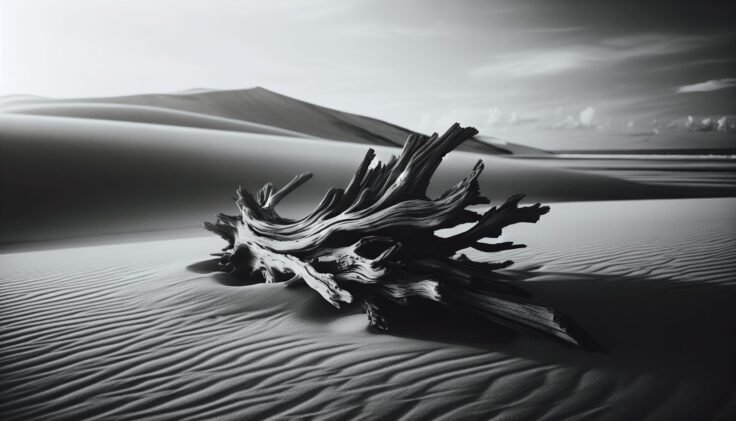Have you ever wondered why driftwood in black and white photography captivates the eye in such a unique way? There’s something enchanting about the timelessness and simplicity of black and white imagery, especially when it portrays the textured and intricate forms of driftwood. In this article, you’ll unravel the aesthetic appeal and symbolic underpinnings of driftwood captured through the lens of monochrome photography. Get ready to embark on a journey through art, nature, and the nuanced interplay between light and shadow.

The Magic of Black and White Photography
Black and white photography has the power to transform the ordinary into the extraordinary. Without the distraction of color, the focus shifts to composition, contrast, and texture. In the world of monochrome artistry, driftwood becomes an ideal subject, its natural complexity unfolding in rich detail. The grayscale palette brings out patterns and shapes that might otherwise go unnoticed, letting you appreciate the organic beauty of nature in all its intricacies.
Why Choose Black and White?
You might wonder why black and white photography continues to hold a special place in an era dominated by high-definition color images. The absence of color allows for a deeper emotional connection, emphasizing the mood and atmosphere of a scene. For subjects like driftwood, this means letting the unique lines, forms, and textures speak volumes, often telling stories of time, weathering, and the journey of these natural sculptures across waters.
Revealing Details Through Contrast
In black and white imagery, contrast plays a pivotal role in bringing images to life. The interplay of bright and dark areas creates a visual language that emphasizes the most compelling aspects of driftwood. This is where the grain of the wood, the knots, and even the smallest ridges become focal points, inviting your eye to travel over them and discover the hidden depths within their curves and angles.
The Allure of Driftwood
Driftwood refers to wood that has washed ashore, sculpted by the forces of water, wind, and time. Its journey and transformation contribute to its fascinating shapes, making it a sought-after subject for artists and photographers alike.
Nature’s Sculptures
Driftwood is often seen as nature’s form of abstract art. Each piece bears unique scars and patterns, chronicling the narrative of its travels. The wood’s texture, smoothed by its passage through water, stands in stark contrast to the rugged, often jagged forms it can take. In black and white, these characteristics are heightened, allowing you to see driftwood as not just debris, but as arresting natural sculptures.
Symbolism and Stories
For many, driftwood symbolizes resilience and transformation. It tells stories of survival and adaptation, of being carried by currents and shaped by the elements. In photography, capturing driftwood in black and white highlights these aspects, making you ponder on its past journey and its place within the natural world.
Capturing the Perfect Shot
Creating compelling black and white images of driftwood requires both technical skill and an eye for composition. Here are a few tips to help you capture stunning images.
The Importance of Lighting
You’ll find that lighting is one of the most critical elements in photography. Natural light, especially during the golden hours — shortly after sunrise and before sunset — can add depth to your photos, while overcast skies can provide the soft shadows that help elaborate textures stand out.
Composition and Angles
Composition in photography is about arranging the elements in a frame in a way that draws the viewer’s eye. When photographing driftwood, consider different perspectives and angles. Experiment with close-ups that emphasize texture or wide-angle shots that capture the driftwood in its environment. Always remember the rule of thirds, placing the subject off-center to create a more balanced image.
Post-Processing Techniques
Post-processing is where good photos can become extraordinary. In black and white photography, you can adjust contrast, brightness, and clarity to enhance important details. Many photographers use software tools to manipulate shades of gray, bringing out dimensions and ensuring that the driftwood’s natural beauty is faithfully represented.
Driftwood in Art and Design
The unique character of driftwood has inspired various forms of artistic and practical applications. Beyond photography, it’s celebrated in sculptures and even interior design.
Driftwood Sculptures
Many artists use driftwood as a primary medium for sculptures. The wood’s inherent shapes often dictate the final form, resulting in pieces that range from abstract to literal representations of animals and humans. These sculptures often rely on the natural contours and textures of the driftwood, made even more impressive when the gradations are enhanced in monochrome photography.
Interior Design Using Driftwood
Driftwood brings a rustic and natural charm to interior spaces. In black and white photos, they can serve as stunning decorative elements, providing a touch of nature that complements modern or traditional rooms alike. Driftwood can be fashioned into functional items like coat racks and lamps, or remain as a purely aesthetic focal point.

The Emotional Impact
The emotive qualities of driftwood photography in black and white go beyond just aesthetics. They evoke feelings of nostalgia, solitude, and reflection.
Connection to Nature
Photographing driftwood in monochrome can foster a connection to nature, inviting viewers to pause and consider the world around them. The evocative power of black and white images often invokes a sense of calm and introspection, allowing you to appreciate the silent beauty of natural forms.
Reflections on Time and Change
Driftwood embodies change and the passage of time, echoing themes that resonate deeply on a human level. In black and white, these aspects are emphasized, asking you to reflect on your own journey and transformation, much like the wood that has traveled immense distances, shaped by the forces of nature.
How to Display Your Driftwood Photography
Once you’ve captured the essence of driftwood in your black and white images, consider the best ways to display them.
Framing Ideas
The right frame can complement your photograph and the space it occupies. Simple, minimalist frames tend to work best with black and white photos, keeping the focus on the imagery. Consider using natural wood frames to create a thematic connection with the driftwood subject.
Gallery Walls and Layout
Creating a gallery wall can be an exciting way to showcase your work. A collection of driftwood photos in various sizes can create a dynamic visual story. Playing with arrangement and spacing can add unique interest and allow the wall to be a statement piece.
Utilizing Online Platforms
In our digital age, showcasing art online can reach an audience far beyond local galleries. Consider setting up a digital portfolio or using social media platforms dedicated to photography. This not only helps in sharing your view with a broader audience but also opens doors to networking with other art enthusiasts and photographers.
Conclusion
Driftwood in black and white photography offers a timeless and profound exploration of nature’s art. It highlights the beauty of natural decay, transformation, and survival in ways color photography might not fully capture. By focusing on composition, contrast, and texture, you can reveal the intrinsic allure of driftwood, telling its story through the stark elegance of monochrome. Whether you’re capturing it with your camera, presenting it in your home, or sharing it with the world online, driftwood reproduced in black and white imagery commands attention and evokes emotion, painting a powerful picture of the natural world’s relentless passage.
So next time you find yourself strolling along the shore, take a closer look at those pieces of driftwood. Imagine the stories they tell and the artistic potential they hold, just waiting to be captured through the lens of a black and white photograph. Embrace their journey, and perhaps even yours, through the canvas of monochrome art.